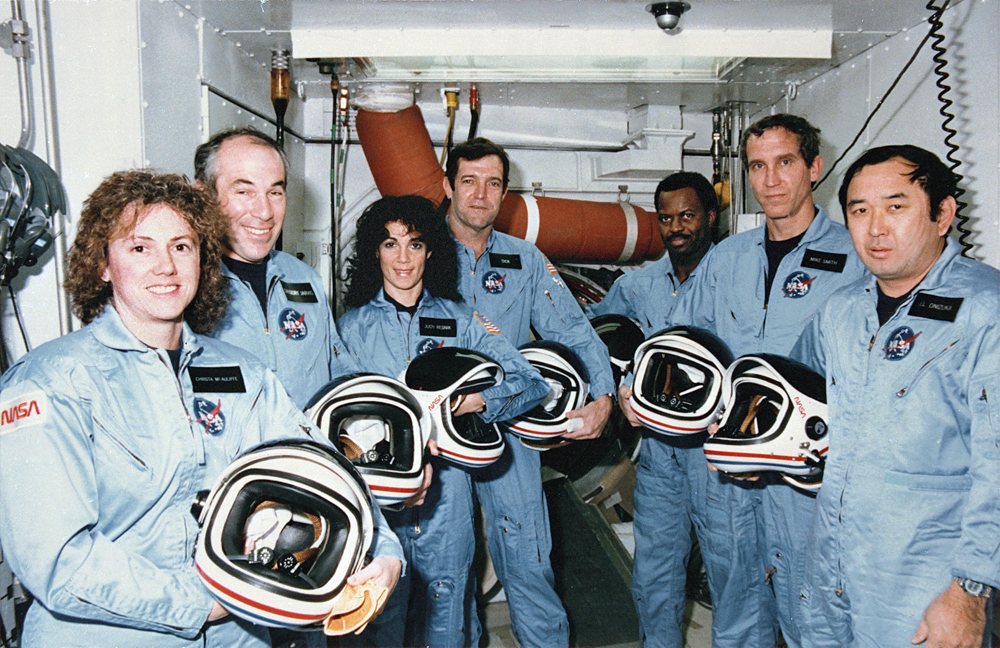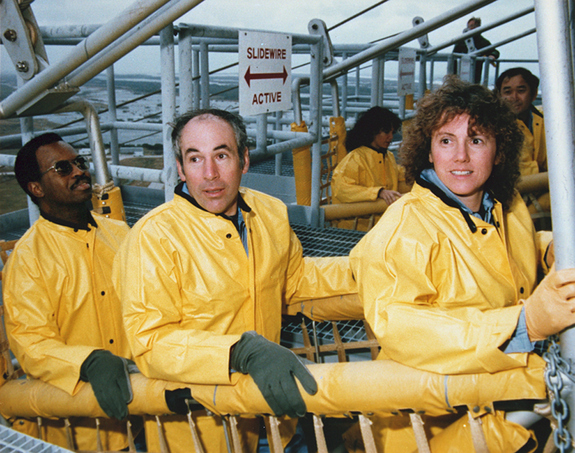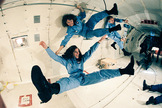
The crew of the space shuttle Challenger’s STS-51L mission, which ended in tragedy 73 seconds after launch on Jan. 28, 1986. From left to right: Christa McAuliffe, Gregory Jarvis, Judy Resnik, Dick Scobee, Ronald McNair, Michael Smith and Ellison Onizuka.
Credit: NASA
Thirty years ago today, NASA suffered a spaceflight tragedy that stunned the world and changed the agency forever.
On Jan. 28, 1986, the space shuttle Challenger exploded just 73 seconds after blasting off from Florida’s Kennedy Space Center, killing all seven astronauts on board — including New Hampshire educator Christa McAuliffe, a civilian who had been selected to fly via NASA’s “Teacher in Space” program.
NASA astronauts had died on the job before — Apollo 1 crewmembers Ed White, Gus Grissom and Roger Chaffee were lost when a fire broke out inside their command module during a launchpad exercise on Jan. 27, 1967 — but the Challenger disaster was something different altogether. [Remembering Challenger: NASA’s 1st Shuttle Tragedy (Photos) ]
“The whole country and the whole world were in shock when that happened, because that was the first time the United States had actually lost a space vehicle with crew on board,” said former NASA astronaut Leroy Chiao, who flew three space shuttle missions during his career (in 1994, 1996 and 2000), and also served as commander of the International Space Station from October 2004 through April 2005.
“It was even more shocking because Christa McAuliffe was not a professional astronaut,” Chiao told Space.com. “If you lose military people during a military operation, it’s sad and it’s tragic, but they’re professionals doing a job, and that’s kind of the way I look at professional astronauts. But you’re taking someone who’s not a professional, and it happened to be that mission that got lost — it added to the shock.”
Changing the culture
Credit: by Karl Tate, Infographics artist
Before Challenger launched on its ill-fated STS-51L mission, the space shuttle program had completed 24 missions in a row, starting with the April 1981 liftoff of the orbiter Columbia. That run of success bred a measure of complacency, Chiao said.
“There was a ‘launch fever’ at the time, to try to get these missions off on time, and get more missions going,” he said.
That type of thinking played a significant role in the disaster, experts have concluded. Challenger was lost because a rubber “O-ring” seal on the shuttle’s right-hand solid rocket booster failed, allowing hot gas to escape and damage the orbiter’s external fuel tank, as well as the gear that attached the booster to the tank.
The O-ring failed in part because unusually cold temperatures on launch day caused the part to harden, investigators later determined. The temperature at liftoff time was 36 degrees Fahrenheit (2 degrees Celsius) — 15 degrees F (8 degrees C) colder than any previous shuttle launch, NASA officials have said. [NASA Remembers Challenger (Video) ]
“The decision to launch the Challenger was flawed. Those who made that decision were unaware of the recent history of problems concerning the O-rings and the joint, and were unaware of the initial written recommendation of the contractor advising against the launch at temperatures below 53 degrees Fahrenheit [11.7 degrees C] and the continuing opposition of the engineers at Thiokol [Morton Thiokol, which built the shuttle’s solid rocket boosters] after the management reversed its position,” investigators wrote in their report about the disaster, which is known as the Rogers Commission Report.
“They did not have a clear understanding of Rockwell’s concern that it was not safe to launch because of ice on the pad,” they added. (Rockwell International built the space shuttles for NASA.) “If the decision-makers had known all of the facts, it is highly unlikely that they would have decided to launch 51L on Jan. 28, 1986.”
In a way, the accident jolted these decision-makers awake, Chiao said.
“A lot of things changed,” he said. “The space shuttle had to be entirely re-certified. Every last little technical piece was re-analyzed.”
This work took nearly three years. The shuttle program was grounded until the orbiter Discovery blasted off on Sept. 29, 1988.

The STS-51L Challenger flight crew receives emergency egress training in the slide wire baskets. They are (L to R) Mission Specialist, Ronald McNair, Payload Specialist, Gregory Jarvis, Teacher in Space Participant, Christa McAuliffe. Directly behind them are Mission Specialist Judy Resnik and Mission Specialist, Ellison Onizuka.
Credit: NASA
Fallen heroes
The Challenger disaster claimed the lives of seven people: commander Francis “Dick” Scobee; pilot Mike Smith; mission specialists Judith Resnik, Ron McNair and Ellison Onizuka; and payload specialists McAuliffe and Greg Jarvis.
They are still missed today, three decades later.
“Thirty years just seems like yesterday,” said Barbara Morgan, who served as McAuliffe’s “Teacher in Space” backup and eventually made it to orbit herself in 2007, aboard the space shuttle Endeavour. “These people are still with me all the time, every day.”
Morgan said that McAuliffe and the “Teacher in Space” program had a huge impact, even though the STS-51L mission ended in tragedy.

Teacher in space Christa McAuliffe (top), backup crew member Barbara Morgan (bottom) and payload specialist Greg Jarvis (back right) training in a KC-135 “vomit comet” in the 1980s.
Credit: NASA JSC Image Repository and Terry Slezak
“It was a really bad time for education. A huge study had come out — a big document called ‘A Nation at Risk,’ and it talked about how bad our education system was, and it kind of painted all schools and all teachers with a big, broad, bad paintbrush,” Morgan told Space.com. “There was a very popular saying at the time: ‘Those that can, do. Those that can’t, teach.'”
But McAuliffe helped change that perception, she added.
“Christa was just a wonderful teacher, a wonderful human being and a wonderful representative of our profession, and that made it so that it got turned around,” Morgan said. “That’s something that I’m really, really grateful for, and proud of.”
Just a few months after the Challenger accident, the fallen astronauts’ family members set up a nonprofit called the Challenger Center for Space Science Education , which seeks to spark students’ interest in science, technology and math by giving them exciting, hands-on experiences in these fields.
The Challenger Center has reached nearly 4.5 million kids over the last 30 years, Morgan said.
The nonprofit is a “living legacy to education, carrying on the education mission that Challenger was all about,” she said. “To me, that speaks volumes about what the crew was like and who they were, and it’s reflected in their wonderful families as well.”
Keep exploring
Sadly, Challenger was not the space shuttle program’s only tragedy. On Feb. 1, 2003, the orbiter Columbia broke apart upon re-entering Earth’s atmosphere, killing all seven astronauts on board.
These crewmembers were commander Rick Husband; pilot William McCool; payload commander Michael Anderson; mission specialists David Brown, Kalpana Chawla and Laurel Clark; and payload specialist Ilan Ramon, from the Israel Space Agency.
A piece of insulating foam had broken off Columbia’s external fuel tank during the orbiter’s launch more than two weeks earlier, damaging the shuttle’s left wing. Investigators later determined that this damage allowed hot atmospheric gases to enter the wing’s interior, leading to the shuttle’s destruction. (Some complacency had crept back into the shuttle program by 2003, Chiao said; foam shedding had been observed during previous shuttle launches but had not been deemed a potentially catastrophic phenomenon.) [Columbia Space Shuttle Disaster Explained (Infographic) ]
Disasters such as the losses of Challenger and Columbia serve as reminders that spaceflight is an inherently difficult and risky proposition, Chiao said.
“I don’t think space travel will ever be as safe as commercial air travel, just because the amount of energy you have to put into a vehicle to accelerate it to orbital speed at 17,500 mph [28,160 km/h] — any time you have to put that much energy into a vehicle, and then take it out again to bring it back, there’s going to be risk involved,” he said.
“Unfortunately, as much as we try to minimize and avoid these mishaps, every now and then we’re going to have them happen,” Chiao added. “What we have to do is, do what we can to learn from them, apply lessons learned and keep moving forward.”
NASA’s path forward does not include the space shuttle; the agency grounded its remaining orbiters for good in July 2011. American astronauts are currently dependent upon Russian Soyuz spacecraft to get to and from the International Space Station, though NASA has said it hopes private spacecraft developed by Boeing and SpaceX will be ready to take over this taxi service by late 2017.
NASA’s human spaceflight program, meanwhile, is focused on getting people to Mars sometime in the 2030s (with a mission to a captured asteroid in lunar orbit in the 2020s currently envisioned as a sort of stepping stone).
The agency is developing a capsule called Orion and a huge rocket called the Space Launch System to make all this happen.
“I know we’re going to get there,” Morgan said of Mars. “It’s taken longer than I think we all wished, but it’s exciting.”
You can learn much more about the Apollo 1, Challenger and Columbia tragedies here: http://www.nasa.gov/externalflash/DOR2016/index.html
Follow Mike Wall on Twitter @michaeldwall and Google+ . Follow us @Spacedotcom , Facebook or Google+ . Originally published on Space.com .

Comments are closed.